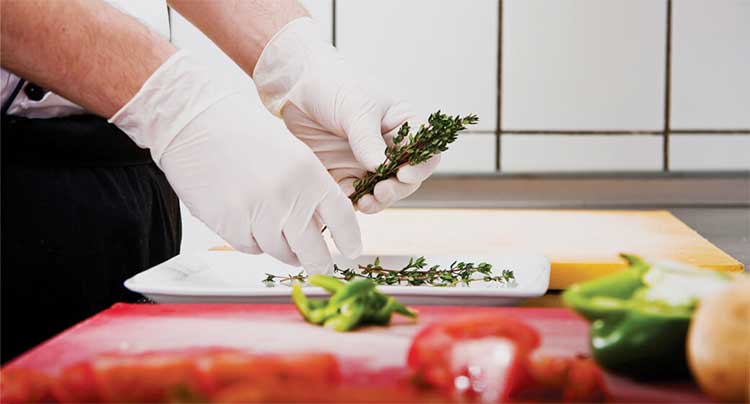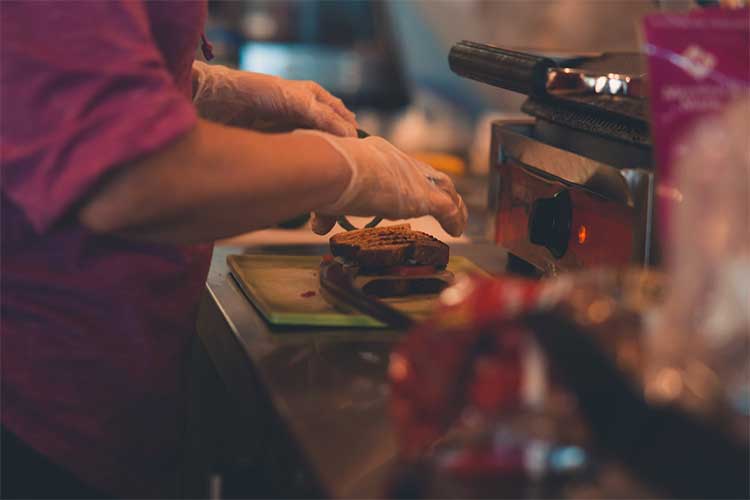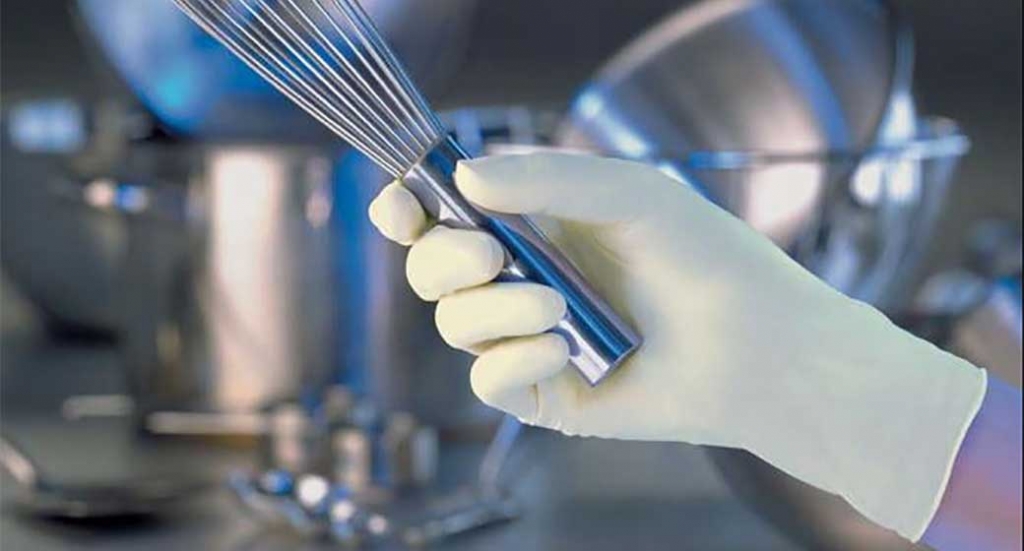The New Normal: Part of a new series of articles focused on restaurant recovery; issues, best practices, and process changes that will become part of everyday business going forward.
Glove use is going to increase dramatically for restaurants and foodservice workers in the post-COVID-19 era. Unfortunately, gloves can provide a false sense of security for workers. Now is the time to begin training your employees on the best practices for glove use in restaurants and foodservice.
It’s Not About You
The most common misconception we hear about glove use in restaurants is that the glove is used to protect the worker. While this may be true, that is not the intention of using gloves in a restaurant or foodservice setting. Instead, gloves are meant to avoid cross-contamination.
Cross-contamination is the process by which bacteria, viruses, or other micro-organisms are unintentionally transferred from one surface, substance, or object to another, with harmful effects.
The FDA is pretty clear about the need to use gloves properly, stating, “Gloves may serve as a source of cross-contamination if misused.”
The revised Food Code of 2017 states:
“Except when washing fruits and vegetables…FOOD EMPLOYEES may not contact exposed, READY-TO-EAT FOOD with their bare hands and shall use suitable UTENSILS such as deli tissue, spatulas, tongs, single-use gloves, or dispensing EQUIPMENT.”
In other words, if it is food that is going to be consumed without further cooking or preparation, you cannot touch it with your bare hands.

Single-Use Means Just That
We may refer to them as “disposable gloves” or by the name of what they are made of like “nitrile gloves” or “vinyl gloves.” But they are collectively known as “single-use gloves.”
Single-use means that a pair of gloves should only be used for one activity. If you switch to a new activity, you should use a new pair of gloves.
If you switch to do the same activity on a different food product, you should also change gloves.
When to Change Gloves
OK. So we have established that you should change gloves when you change activities. But that doesn’t mean that you should keep the same pair of gloves on all day if you are only doing one thing. There are a number of other reasons to change your gloves.
- If your glove becomes torn or damaged, replace it immediately
- If your glove becomes soiled, consider changing it
- After touching raw seafood, poultry or other meat, change your gloves before touching other food items
- If your glove becomes contaminated (e.g., you cough on your glove, you sneeze on your glove, you wipe your nose/mouth/eyes, etc.)
- Gloves should be changed at least every 4 hours regardless of use. Changing every 2 hours is even better
If you even have an inkling that you should change your gloves, then you should probably change your gloves.
The Real Secret: Wash Your Hands Before & After
This is probably the most important best practice for glove use. You need to wash your hands before you put on a new pair of gloves. And you need to wash your hands after removing a pair of single-use gloves. Simply put, you need to wash your hands between every glove change.
Many people mistakenly think that they don’t need to wash their hands before putting on a pair of single-use gloves. They believe that the gloves are the protection. But if you really want to reduce the risk of cross-contamination, you must wash your hands before you put on your gloves.
Experts suggest putting the glove dispenser near or above a dedicated handwashing sink to reinforce the idea that workers must wash their hands before putting on gloves.

FAQ on Best Practices for Glove Use
Q: What kinds of foods may not be touched with bare hands?
A: From the New York Health Department:
- prepared fresh fruits and vegetables served raw;
- salads and salad ingredients;
- cold meats and sandwiches;
- bread, toast, rolls and baked goods;
- garnishes such as lettuce, parsley, lemon wedges, potato chips or pickles on plates;
- fruit or vegetables for mixed drinks;
- ice served to the customer;
- any food that will not be thoroughly cooked or reheated after it is prepared
Q: Why do I need to wash my hands before putting on gloves?
A: As we said, gloves are not magical. They do not kill bacteria, viruses, etc. They simply help to reduce the spread of these infectious agents. Handwashing does actually reduce the presence of infectious agents. And a study by Food Safety Magazine showed that 50% of the time, glove wearers fail to notice glove punctures, tears, and other damage. Therefore, workers need to start with the cleanest hands possible simply to prevent accidental contamination.
Q: Can I remove and reuse gloves if I don’t switch activities?
A: No. Once a glove is removed, it cannot be reused.
Q: Do I need to change gloves after handling money?
A: Surprisingly, the legal answer is “no.” But the real answer is more complicated. Paper money and coins have consistently shown to retain a variety of infectious agents. And one of the most common complaints to health departments occurs when customers observe foodservice workers handling money and subsequently handling food without changing gloves. So while it may not be required, it is definitely a best practice to wash your hands and change gloves between handling money and food.
Q: Do I need to change gloves after answering the phone?
A: Yes. Phone handsets are a double whammy. Phones are typically handled by multiple people. And the user holds the receiver close to their face and mouth. So if you touch the phone receiver handset, you definitely should change gloves before resuming or starting another activity.
Q: Do cooks need to wear gloves while cooking?
A: The answer is, “it depends.” It may be a good idea to have cooks wear gloves in addition to using other equipment and tools such as tongs, spatulas, and deli paper to prevent direct skin contact with foods that are being prepared.
Q: Is there a difference between Latex, Nitrile, Polyethylene, and Vinyl gloves?
A: Yes! But the answer is a little more complicated than we have space for here. But you are in luck because we answered this question in extensive detail in our article: Disposable Gloves Buying Guide: Vinyl vs Latex vs Poly vs Nitrile Gloves – Check it out!
Q: I heard that Latex gloves are bad and have been banned from restaurants. Is that true?
A: Latex gloves have been controversial. Some people have an allergy to latex and even contact with latex gloves during food preparation can cause severe allergic reactions. At the time of this writing, seven states have banned latex gloves for foodservice. They include California, Ohio, Connecticut, Oregon, Hawaii, Arizona, and Rhode Island.
The Bottom Line on Single-Use Gloves for Foodservice
Single-use gloves can be an effective tool in preventing cross-contamination when used appropriately. They are never a substitute for handwashing or other best practices in food handling and storage. As our world continues to evolve in the COVID-19 era, we expect to see a drastic increase in glove use in restaurants and other foodservice professions.
We believe that servers, cashiers, and other employees who may not be directly involved in food preparation will be wearing gloves as a standard procedure to prevent contamination spread. However, it will be important for the operators to correctly train their staff on how to appropriately use gloves within their roles.





Great information shared about disposable gloves. Would love to read more content related to disposable gloves.
Gloves are used by chefs and kitchen staff to handle raw ingredients and prepare food. This helps to prevent cross-contamination between different types of food, and ensures that the food is safe to eat.
Can you walk out into the dining room with the gloves on
We can’t be sure exactly what or why you are asking from just your question, but the answer is “it depends.” While there is no overarching guideline for glove use in the dining room, it is often considered a best practice to change gloves when changing zones or activities in a restaurant. For example, if you were washing dishes with gloves on and then were asked to bus tables, you should change gloves at that time. Of course, your state and local regulations may vary and a particular employer may implement their own policies as long as they do not contradict the official regulations. Hope that helps to answer your question and it is probably a good time to remind every one of proper glove procedures for restaurant employees.